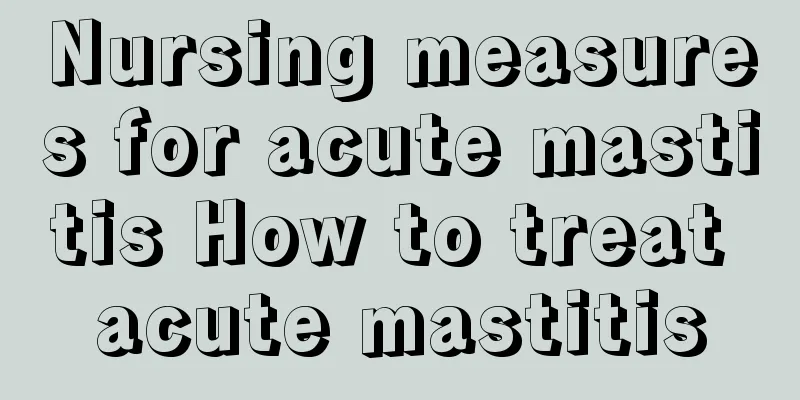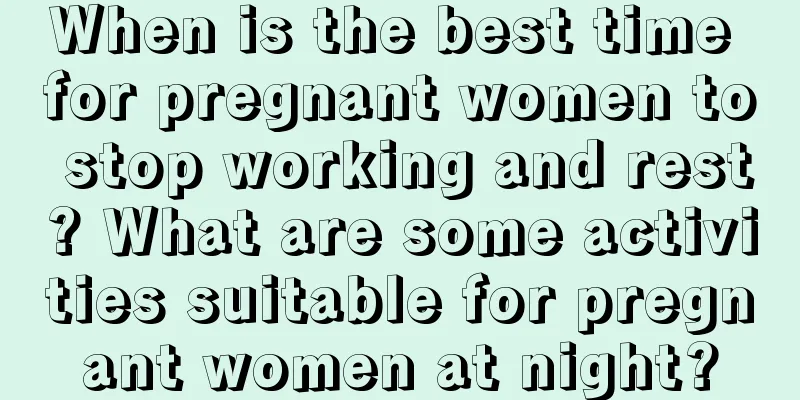Nursing measures for acute mastitis How to treat acute mastitis

|
Many mothers suffer from mastitis due to improper nursing and feeding methods after childbirth. Mastitis is not a terrible serious disease. As long as it is treated well and the nursing methods are mastered, it can be recovered quickly. Here I will tell you how to properly care for mastitis. Nursing of acute postpartum mastitisIn case of acute mastitis, breastfeeding should not be stopped, because stopping breastfeeding not only affects the feeding of the baby, but also increases the chance of milk stasis. Therefore, when you feel breast pain, swelling or even local skin redness, you should not stop breastfeeding, but also feed your child frequently to let the child eat up as much milk as possible. When localized breast suppuration occurs, breastfeeding should be stopped on the affected breast, and the milk should be drained out by common milking techniques or a breast pump to facilitate smooth milk discharge. At the same time, the child can still drink breast milk from the other healthy breast. Only when the infection is severe or the abscess is incised and drained, or when breast atrophy occurs, should breastfeeding be completely stopped, and active measures to stop milk production should be taken according to the doctor's advice. The key to preventing acute mastitis during lactation is to avoid milk stasis, prevent nipple damage, and keep nipples clean. After breastfeeding, nipples should be cleaned in time, and health care during pregnancy should be strengthened; if nipples are inverted, they can be squeezed and pulled frequently for correction; after delivery, develop the habit of regular breastfeeding, and do not let the baby sleep with the nipple in his mouth; after each breastfeeding, try to let the baby suck out the milk. If there is stasis, massage or use a breast pump to drain the milk; at the same time, pay attention to the baby's oral hygiene. If the nipples are damaged or cracked, they need to be treated in time. Self-massage method to prevent and treat mastitisPush and caress method: The patient sits or lies on his side, fully exposing his chest. First, sprinkle some talcum powder or apply a little paraffin oil on the affected breast, then use both hands to gently push and caress along the breast duct towards the nipple 50 to 100 times. Kneading method: Use the hypothenar or thenar eminence of the palm to apply pressure to the affected area, and gently knead the red, swollen and painful areas. Knead the areas with lumps repeatedly several times until the lumps become soft. Kneading, pinching, and holding method: Use the five fingers of your right hand to grab the affected breast and knead it, grabbing and loosening it, repeating the procedure 10 to 15 times. Use your left hand to gently pull the nipple several times to expand the milk ducts in the nipple. Oscillation method: Use the right hand hypothenar eminence to push from the breast lump along the breast root to the nipple with high-speed oscillation, repeat 3 to 5 times. The effect is better when there is a slight warm feeling locally. How to prevent mastitis1. Ensure that the breastfeeding posture and the baby's sucking method are correct. Do not let the baby only suck the nipple, causing nipple cracks, so that bacteria can enter the mammary duct along the cracked nipple and cause acute mastitis. 2. When breastfeeding, make sure to let the baby finish one breast before feeding the other. Do not alternate between the two breasts to prevent the baby from not getting milk for a long time, which may cause milk stasis and acute mastitis. If the mother's milk is sufficient and the baby is full after eating from only one breast, and the other breast is swollen, the milk from the swollen breast must be squeezed out and not left in the breast to prevent the formation of a lump and acute mastitis. At the same time, develop the habit of breastfeeding regularly and do not let the baby sleep with the nipple in his mouth. 3. Do not wear a bra with underwire. Mothers' milk often leaks out inadvertently, and the breasts sag due to breast milk filling. At this time, new mothers should not wear a bra with underwire. It is best to wear a special nursing bra to prevent the bra with underwire from squeezing the milk ducts and causing local milk congestion, which may lead to acute mastitis. 4. Sleeping on the side and lying on the back should be done alternately. Mothers are forbidden to sleep on their stomachs to prevent milk congestion and acute mastitis caused by squeezing the breasts. Sleeping on your stomach can easily squeeze your breasts, causing milk stasis and acute mastitis 5. Pay attention to your own hygiene. It is best to wipe the nipples with clean water before and after feeding the baby, and then wipe them clean with a hygienic towel to keep them clean. 6. Do not rush to stimulate lactation after childbirth. Postpartum nutritional supplements are not necessarily more the better. Fish soup, meat soup or chicken soup that helps to increase lactation must be consumed in moderation according to the amount of milk secretion. Because some new mothers' mammary ducts are not yet unobstructed when they start to secrete milk, and the sucking ability of newborns is weak, if a large amount of milk is secreted, it is easy to cause milk swelling and lumps, which will bring pain to new mothers. Therefore, postpartum milk-inducing foods should be consumed in small amounts. 7. During the pus formation period of mastitis, you should eat less fishy soups that have the effect of "producing milk" to avoid aggravating the condition. It is better to eat more vegetables and fruits that have the effect of clearing heat, such as tomatoes, green vegetables, loofah, cucumber, mung bean, fresh lotus root, kumquat cake, etc. Kelp has the effect of softening and dispersing nodules, so you can eat more. At the same time, keep your mood happy. 8. Pay attention to diet adjustment: eat light and nutritious food, eat more fresh vegetables and fruits, such as tomatoes, loofah, cucumber, fresh lotus root, oranges, etc. Avoid spicy, irritating, meaty and greasy foods. How to treat mastitis1. New mothers who give birth for the first time are prone to acute mastitis. There are two reasons for this. First, the body is weak after childbirth and the resistance is reduced. Due to milk stasis, it is easy to breed bacteria. Second, the skin of the nipples and areolas of new mothers is relatively thin, which can easily lead to nipple damage and bacterial infection! If the treatment is not timely or improper, the lesion will continue to develop, causing the affected breast to become more red and swollen, the lump to increase and soften, and fluctuate, and it is easy to form subcutaneous or superficial breast abscesses. In this way, the scope of the lesion will become more and more serious, and even enter the chest wall muscles, and the systemic symptoms will become more and more obvious! So what should I do if I get acute mastitis after childbirth? How to treat it? 2. Early treatment is the only way to prevent excessive damage to the breast. First of all, breastfeeding on the affected breast should be stopped as soon as possible, and breast milk should be pumped regularly. The affected breast can be lifted up with a bra or a sling, which can improve the blood circulation of the breast. If the blood circulation is smooth, the local area will not be congested, the swelling will disappear easily, and the inflammation can be quickly controlled! 3. You can use external application, internal treatment and physical therapy! Cold compress can be used locally in the early stage. If suppuration is inevitable, hot compress can be used. 3 to 4 times a day, about 30 minutes each time. It is better if it can be applied externally continuously. For local redness and swelling, you can apply the Chinese medicine Huangjinsan! For internal treatment, it means oral or injection of Kangbing bacteria drugs, or use Chinese medicine Shuanghua and Dandelion. Soapberry decoction! Co-trimoxazole, penicillin, gentamicin, etc. can be used, but it should be considered that the baby needs to breastfeed, and tetracycline and sulfonamide drugs should not be used! In addition, infrared irradiation can be used, and ordinary 100-watt light bulbs are also fine. This can promote local blood circulation and facilitate the absorption and dissipation of inflammation! |
>>: What should I do if my baby loves watching TV? Does it have any effect on the baby's eyes?
Recommend
Is Kunling's second child a boy or a girl?
Kunling's first child was Xiao Zhou Zhou, a c...
Good parental concepts naturally increase the chances of pregnancy
Recently, there have been frequent reports of cel...
Is it good for babies to use walkers? Is it good for babies to use walkers?
A baby walker is one of the facilities that many ...
What should I do if I have a difficult birth in water? Which is better, water birth or painless birth?
Although water birth can help mothers relieve pai...
What to do if your baby is constipated after drinking milk powder? What milk powder should your baby drink without constipation?
Everyone should be familiar with milk powder. In ...
Can dandelion remove fetal toxins? What can I eat to remove fetal toxins?
Dandelion is a plant that many people like to pla...
What should children pay attention to when washing their hands when they go out to play? How to wash hands correctly
After the children played on the slide in the par...
Is it normal for babies to always bend their feet when sleeping? Why do babies always cross their feet when sleeping?
Babies have all kinds of strange sleeping positio...
How to prevent your baby from stuttering? What are the misunderstandings about your baby's language development?
Stuttering is a language disorder. To prevent stu...
Does painless abortion have any impact on women's future pregnancy?
Parents need to make many preparations for the bi...
Things to note during early pregnancy:
There are many things to pay attention to in the ...
What should I do if my baby has a poor appetite? How to solve the problem of my baby's poor appetite
For many new parents, taking care of babies is no...
The impact of pregnant women crying on the fetus. Twelve kinds of food that pregnant women must eat
If a pregnant woman's mood fluctuates greatly...
What are the symptoms of children's tooth replacement? What should children pay attention to when they change their teeth?
Usually, children will have their teeth replaced ...
How to supplement calcium for babies? How to make calcium supplement recipes for babies
Our physical health is very important, especially...









